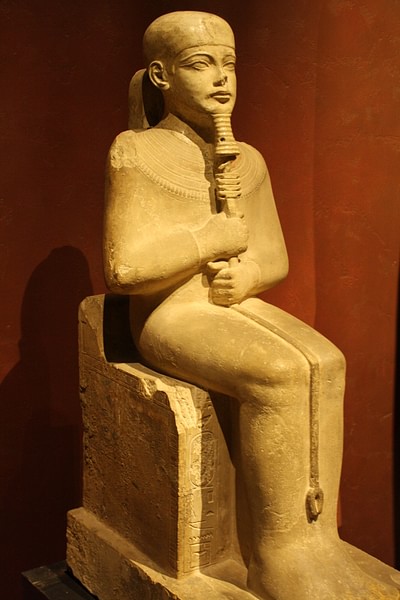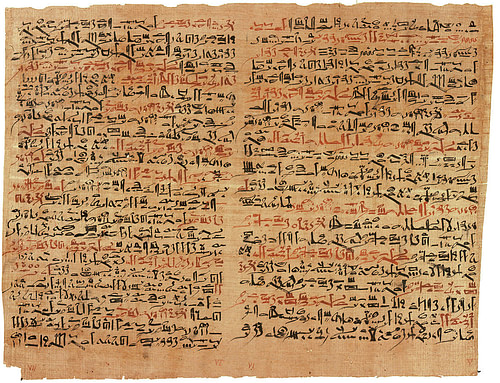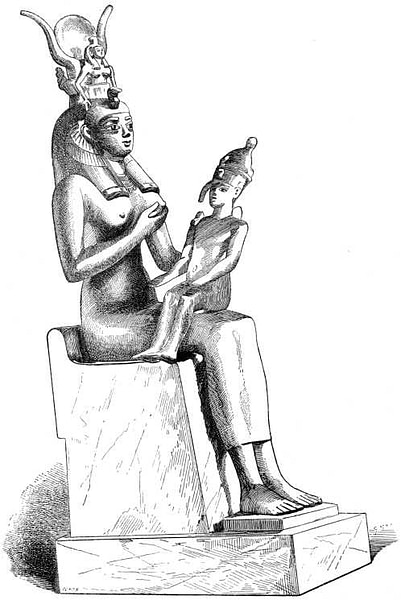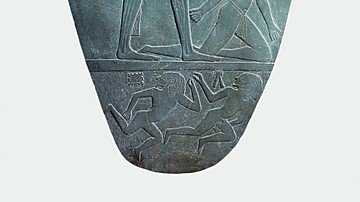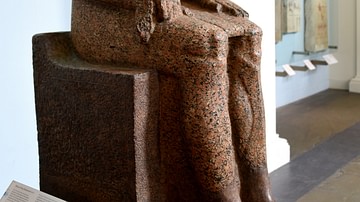
Ancient Egyptian culture flourished between c. 6000 BCE with the rise of technology (as evidenced in the glasswork of faience) and 30 BCE with the death of Cleopatra VII, the last Ptolemaic ruler of Egypt. It is famous today for the great monuments which celebrated the triumphs of the rulers and honored the gods of the land.
The culture is often misunderstood as having been obsessed with death but, had this been so, it is unlikely it would have made the significant impression it did on other ancient cultures such as Greece and Rome. The Egyptian culture was, in fact, life-affirming, as the scholar Salima Ikram writes:
Judging by the numbers of tombs and mummies that the ancient Egyptians left behind, one can be forgiven for thinking that they were obsessed by death. However, this is not so. The Egyptians were obsessed by life and its continuation rather than by a morbid fascination with death. The tombs, mortuary temples and mummies that they produced were a celebration of life and a means of continuing it for eternity…For the Egyptians, as for other cultures, death was part of the journey of life, with death marking a transition or transformation after which life continued in another form, the spiritual rather than the corporeal. (ix)
This passion for life imbued in the ancient Egyptians a great love for their land as it was thought that there could be no better place on earth in which to enjoy existence. While the lower classes in Egypt, as elsewhere, subsisted on much less than the more affluent, they still seem to have appreciated life in the same way as the wealthier citizens. This is exemplified in the concept of gratitude and the ritual known as The Five Gifts of Hathor in which the poor laborers were encouraged to regard the fingers of their left hand (the hand they reached with daily to harvest field crops) and to consider the five things they were most grateful for in their lives. Ingratitude was considered a 'gateway sin' as it led to all other types of negative thinking and resultant behavior. Once one felt ungrateful, it was observed, one then was apt to indulge oneself further in bad behavior. The Cult of Hathor was very popular in Egypt, among all classes, and epitomizes the prime importance of gratitude in Egyptian culture.
Religion in Ancient Egypt
Religion was an integral part of the daily life of every Egyptian. As with the people of Mesopotamia, the Egyptians considered themselves co-laborers with the gods but with an important distinction: whereas the Mesopotamian peoples believed they needed to work with their gods to prevent the recurrence of the original state of chaos, the Egyptians understood their gods to have already completed that purpose and a human's duty was to celebrate that fact and give thanks for it. So-called 'Egyptian mythology' was, in ancient times, as valid a belief structure as any accepted religion in the modern day.
Egyptian religion taught the people that, in the beginning, there was nothing but chaotic swirling waters out of which rose a small hill known as the ben-ben. Atop this hill stood the great god Atum who spoke creation into being by drawing on the power of Heka, the god of magic. Heka was thought to pre-date creation and was the energy which allowed the gods to perform their duties. Magic informed the entire civilization, and Heka was the source of this creative, sustaining, eternal power.
In another version of the myth, Atum creates the world by first fashioning Ptah, the creator god who then does the actual work. Another variant on this story is that Ptah first appeared and created Atum. Another, more elaborate, version of the creation story has Atum mating with his shadow to create Shu (air) and Tefnut (moisture) who then go on to give birth to the world and the other gods.
From this original act of creative energy came all of the known world and the universe. It was understood that human beings were an important aspect of the creation of the gods and that each human soul was as eternal as that of the deities they revered. Death was not an end to life but a re-joining of the individual soul with the eternal realm from which it had come.
The Egyptian concept of the soul regarded it as being comprised of nine parts:
- Khat was the physical body
- Ka one's double-form
- Ba was a human-headed bird aspect which could speed between earth and the heavens
- Shuyet was the shadow-self
- Akh was the immortal, transformed self
- Sahu and Sechem aspects were of the Akh
- Ab was the heart, the source of good and evil
- Ren was one's secret name.
An individual's name was considered of such importance that an Egyptian's true name was kept secret throughout life, and one was known by a nickname. Knowledge of a person's true name gave one magical powers over that individual, and this is among the reasons why the rulers of Egypt took another name upon ascending the throne; it was not only to link oneself symbolically to another successful pharaoh but also a form of protection to ensure one's safety and help guarantee a trouble-free journey to eternity when one's life on earth was completed. According to the historian Margaret Bunson:
Eternity was an endless period of existence that was not to be feared by any Egyptian. The term 'Going to One's Ka' (astral being) was used in each age to express dying. The hieroglyph for a corpse was translated as 'participating in eternal life'. The tomb was the 'Mansion of Eternity' and the dead was an Akh, a transformed spirit. (86)
The famous Egyptian mummy (whose name comes from the Persian and Arabic words for 'wax' and 'bitumen', muum and mumia) was created to preserve the individual's physical body (Khat) without which the soul could not achieve immortality. As the Khat and the Ka were created at the same time, the Ka would be unable to journey to The Field of Reeds if it lacked the physical component on earth. The gods who had fashioned the soul and created the world consistently watched over the people of Egypt and heard and responded to, their petitions. A famous example of this is when Ramesses II was surrounded by his enemies at the Battle of Kadesh (1274 BCE) and, calling upon the god Amun for aid, found the strength to fight his way through to safety. There are many far less dramatic examples, however, recorded on temple walls, stele, and on papyrus fragments.
Cultural Advances & Daily Life
Papyrus (from which comes the English word 'paper') was only one of the technological advances of the ancient Egyptian culture. The Egyptians were also responsible for developing the ramp and lever and geometry for purposes of construction, advances in mathematics and astronomy (also used in construction as exemplified in the positions and locations of the pyramids and certain temples, such as Abu Simbel), improvements in irrigation and agriculture (perhaps learned from the Mesopotamians), shipbuilding and aerodynamics (possibly introduced by the Phoenicians) the wheel (brought to Egypt by the Hyksos) and medicine.
The Kahun Gynaecological Papyrus (c. 1800 BCE) is an early treatise on women's health issues and contraception and the Edwin Smith Papyrus (c. 1600 BCE) is the oldest work on surgical techniques. Dentistry was widely practised and the Egyptians are credited with inventing toothpaste, toothbrushes, the toothpick, and even breath mints. They created the sport of bowling and improved upon the brewing of beer as first practised in Mesopotamia. The Egyptians did not, however, invent beer. This popular fiction of Egyptians as the first brewers stems from the fact that Egyptian beer more closely resembled modern-day beer than that of the Mesopotamians.
Glassworking, metallurgy in both bronze and gold, and furniture were other advancements of the culture and Egyptian art and architecture are famous world-wide for precision and beauty. Personal hygiene and appearance was valued highly, and the Egyptians bathed regularly, scented themselves with perfume and incense, and created cosmetics used by both men and women. The practice of shaving was invented by the Egyptians as was the wig and the hairbrush.
By 1600 BCE the water clock was in use in Egypt, as was the calendar. Some have even suggested that they understood the principle of electricity as evidenced in the famous Dendera Light engraving on the wall of the Hathor Temple at Dendera. The images on the wall have been interpreted by some to represent a light bulb and figures attaching said bulb to an energy source. This interpretation, however, has been largely discredited by the academic community.
In daily life, the Egyptians seem little different from other ancient cultures. Like the people of Mesopotamia, India, China, and Greece, they lived, mostly, in modest homes, raised families, and enjoyed their leisure time. A significant difference between Egyptian culture and that of other lands, however, was that the Egyptians believed the land was intimately tied to their personal salvation and they had a deep fear of dying beyond the borders of Egypt. Those who served their country in the army, or those who traveled for their living, made provision for their bodies to be returned to Egypt should they be killed. It was thought that the fertile, dark earth of the Nile River Delta was the only area sanctified by the gods for the rebirth of the soul in the afterlife and to be buried anywhere else was to be condemned to non-existence.
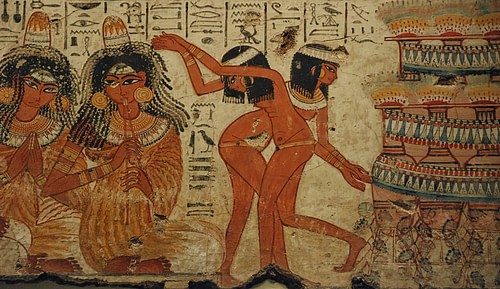
Because of this devotion to the homeland, Egyptians were not great world-travelers, and there is no 'Egyptian Herodotus' to leave behind impressions of the ancient world beyond Egyptian borders. Even in negotiations and treaties with other countries, Egyptian preference for remaining in Egypt was dominant. The historian Nardo writes,
Though Amenophis III had joyfully added two Mitanni princesses to his harem, he refused to send an Egyptian princess to the sovereign of Mitanni, because, 'from time immemorial a royal daughter from Egypt has been given to no one.' This is not only an expression of the feeling of superiority of the Egyptians over the foreigners but at the same time and indication of the solicitude accorded female relatives, who could not be inconvenienced by living among 'barbarians'. (31)
Further, within the confines of the country people did not travel far from their places of birth and most, except for times of war, famine, or other upheaval, lived their lives and died in the same locale. As it was believed that one's afterlife would be a continuation of one's present (only better in that there was no sickness, disappointment or, of course, death), the place in which one spent one's life would constitute one's eternal landscape.
The yard and tree and stream one saw every day outside one's window would be replicated in the afterlife exactly. This being so, Egyptians were encouraged to rejoice in and deeply appreciate their immediate surroundings and to live gratefully within their means. The concept of ma'at (harmony and balance) governed Egyptian culture and, whether of upper or lower class, Egyptians endeavored to live in peace with their surroundings and with each other.
Class Distinctions in Egyptian Culture
Among the lower classes, homes were built of mud bricks baked in the sun. The more affluent a citizen, the thicker the home; wealthier people had homes constructed of a double layer, or more, of brick while poorer people's houses were only one brick wide. Wood was scarce and was only used for doorways and window sills (again, in wealthier homes) and the roof was considered another room in the house where gatherings were routinely held as the interior of the homes were often dimly lighted.
Clothing was simple linen, undyed, with the men wearing a knee-length skirt (or loincloth) and the women light, ankle-length dresses or robes which concealed or exposed their breasts depending on the fashion at a particular time. It would seem that a woman's level of undress, however, was indicative of her social status throughout much of Egyptian history. Dancing girls, female musicians, and servants and slaves are routinely shown as naked or nearly naked while a lady of the house is fully clothed, even during those times when exposed breasts were a fashion statement.
Even so, women were free to dress as they pleased, and there was never a prohibition, at any time in Egyptian history, on female fashion. A woman's exposed breasts were considered a natural, normal, fashion choice, and it was in no way deemed immodest or provocative. It was understood that the goddess Isis had given equal rights to both men and women and, therefore, men had no right to dictate how a woman, even one's own wife, should attire herself. Children wore little or no clothing until puberty.
Marriages were not arranged among the lower classes and there seems to have been no formal marriage ceremony. A man would carry gifts to the house of his intended bride and, if the gifts were accepted, she would take up residence with him. The average age of a bride was 13 and that of a groom 18-21. A contract would be drawn up portioning a man's assets to his wife and children and this allotment could not be rescinded except on grounds of adultery (defined as sex with a married woman, not a married man). Egyptian women could own land, homes, run businesses, and preside over temples and could even be pharaohs (as in the example of Queen Hatshepsut, r. 1479-1458 BCE) or, earlier, Queen Sobeknofru, r. c. 1767-1759 BCE).
The historian Thompson writes, "Egypt treated its women better than any of the other major civilizations of the ancient world. The Egyptians believed that joy and happiness were legitimate goals of life and regarded home and family as the major source of delight.” Because of this belief, women enjoyed a higher prestige in Egypt than in any other culture of the ancient world.
While the man was considered the head of the house, the woman was head of the home. She raised the children of both sexes until, at the age of four or five, boys were taken under the care and tutelage of their fathers to learn their profession (or attend school if the father's profession was that of a scribe, priest, or doctor). Girls remained under the care of their mothers, learning how to run a household, until they were married. Women could also be scribes, priests, or doctors, but this was unusual because education was expensive and tradition held that the son should follow the father's profession, not the daughter. Marriage was the common state of Egyptians after puberty, and a single man or woman was considered abnormal.
The higher classes, or nobility, lived in more ornate homes with greater material wealth but seem to have followed the same precepts as those lower on the social hierarchy. All Egyptians enjoyed playing games, such as the game of senet (a board game popular since the Predynastic Period in Egypt, c. 6000-c. 3150 BCE), but only those of means could afford a quality playing board. This did not seem to stop poorer people from playing the game, however; they merely played with a less ornate set.
Watching wrestling matches and races and engaging in other sporting events, such as hunting, archery, and sailing, were popular among the nobility and upper class but, again, were enjoyed by all Egyptians in as much as they could be afforded (save for large animal hunting which was the sole provenance of the ruler and those he designated). Feasting at banquets was a leisure activity only of the upper class although the lower classes were able to enjoy themselves in a similar (though less lavish) way at the many religious festivals held throughout the year.
Sports & Leisure
Swimming and rowing were extremely popular among all classes. The Roman writer Seneca observed common Egyptians at sport the Nile River and described the scene:
The people embark on small boats, two to a boat, and one rows while the other bails out water. Then they are violently tossed about in the raging rapids. At length, they reach the narrowest channels…and, swept along by the whole force of the river, they control the rushing boat by hand and plunge head downward to the great terror of the onlookers. You would believe sorrowfully that by now they were drowned and overwhelmed by such a mass of water when, far from the place where they fell, they shoot out as from a catapult, still sailing, and the subsiding wave does not submerge them, but carries them on to smooth waters. (Nardo, 18)
Swimming was an important part of Egyptian culture, and children were taught to swim when very young. Water sports played a significant role in Egyptian entertainment as the Nile River was such a major aspect of their daily lives. The sport of water-jousting, in which two small boats, each with one or two rowers and one jouster, fought each other, seems to have been very popular. The rower (or rowers) in the boat sought to strategically maneuver while the fighter tried to knock his opponent out of the craft. They also enjoyed games having nothing to do with the river, however, which were similar to modern-day games of catch and handball.
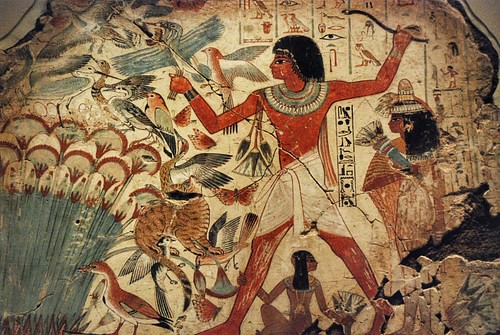
Gardens and simple home adornments were highly prized by the Egyptians. A home garden was important for sustenance but also provided pleasure in tending to one's own crop. The laborers in the fields never worked their own crop and so their individual garden was a place of pride in producing something of their own, grown from their own soil. This soil, again, would be their eternal home after they left their bodies and so was greatly valued. A tomb inscription from 1400 BCE reads, “May I walk every day on the banks of the water, may my soul rest on the branches of the trees which I planted, may I refresh myself under the shadow of my sycamore” in referencing the eternal aspect of the daily surroundings of every Egyptian. After death, one would still enjoy one's own particular sycamore tree, one's own daily walk by the water, in an eternal land of peace granted to those of Egypt by the gods they gratefully revered.
